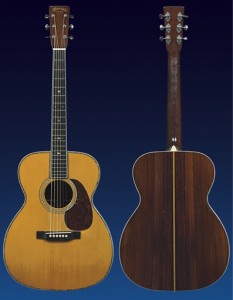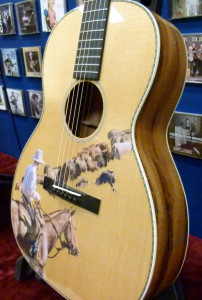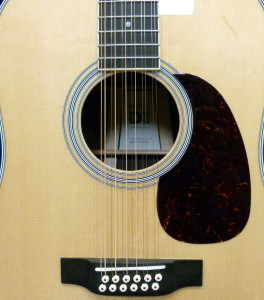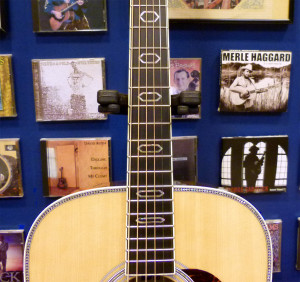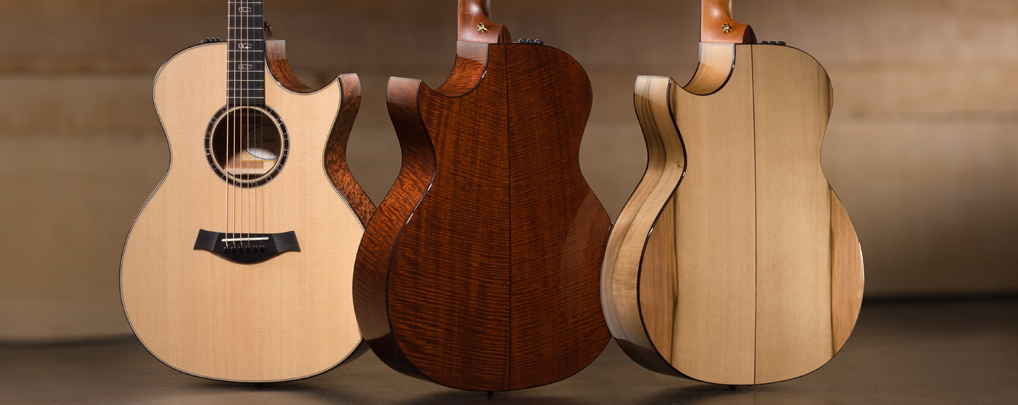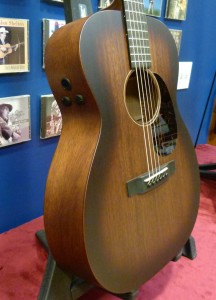New Martins
C. F. Martin & Co. announced their new models for 2016, following up on last week’s sneak preview of the entrants in the Authentic Series, CS Series, and this year’s limited editions.
New String Spacing
A whole new world of acoustic-electrics has appeared in the Standard Series, with a Modified Low Oval profile and the High Performance taper (formerly known as the Performing Artist taper, which referred to the Performing Artist series where it first appeared.)
And starting in 2016 all such guitars have a new string spacing of 2-5/32″, which is 1/32” narrower than the 2-3/16″ that has been used on all previous Martins that have this particular neck, sometimes called their “High Performance Neck.”
According to Tim Teel, Martin’s Director of Design, this change will be affect all Martin models with the High Performance taper.
Tim told me that the change is all about moving the E strings in a tiny bit, to further avoid the strings rolling off the fingerboard when a player pulls them too close to the edge of the a fret.
Since this means a difference of 1/64″ on either side of the fretboard, it should be unnoticeable to guitarists.
New Electronics
Many of these these models come standard with the new Fishman VT Enhance electronics.
The V stands for the Volume control, and the T stands for the Tone control, which are both hidden from sight inside the soundhole, near the bass E string.
The “Enhance” refers to a new control wheel inside the soundhole near the treble E string, which controls an plate transducer – a first for Martin.
This new element picks up its sound-producing energy from the wooden bridge plate, rather than the saddle. This means it will pick up tapping techniques, where the player taps or slaps the guitar’s body, as well as adding an extra dimension to the overall sound, when the bridge plate sensor is blended into the signal from the undersaddle pickup.
The new models in the Standard Series get the Aura® VT Enhance™ system, which comes with a pre-blended Aura microphone image built into the preamp, increasing the “acoustic feel” to the plugged-in tone.
Like the sophisticated Fishman F1 electronics found on the Performing Artist Series and Retro Series Martins, the simpler VT Enhance systems have the 9 volt battery pack installed near the end pin. So the player does not need to take off the strings to change the battery.
While the VT version of the Aura technology does not come with 9 different microphone images, and all the fancy EQ, phase-shift, compressor, and on-board tuner of the Aura F1+ system, it also does not have holes cut into the solid tonewood side of the guitar required to operate all those bells and whistles.
And, frankly, most of us who use Aura systems usually end up with one particular microphone image we like, and then stick with it.
In the of the VT, Fishman and Martin have chosen one microphone image they felt sounded best and was the most versatile for the particular model of guitar, and put that into the preamp, so the player can have a uncomplicated, plug-and-play experience. And now they can blend in a bridge plate transducer along with the simple-to-use volume and tone sweep controls.
And all of it is manipulated by discrete little wheels set just inside the soundhole. Out of the way, and out of sight.
Acoustic-electric Martins below the Standard Series now come with the Matrix® VT Enhance™ electronics, which offers the same bridge plate transducer blend, but does not have the fancier Aura technology.
New Models
There are 17 new Martins between Style 15 and Style 35, as well as two NAMM Show Specials available only to dealers at next week’s trade show in Anaheim, California.
One of the show specials, the SSC-GPC-16, is a Grand Performance with a cutaway and made with cherry sides and back wings, and a flamed maple back wedge, topped by Adirondack spruce. It is available only to the Canadian market. The other show special, the SS-OMVine-16, features ornate aluminum inlays and a body made entirely of figured English walnut, with Adirondack bracing.
New 15s
The uber bargain 15 Series gained two new models, including the return of the OM-15! Only now it is an OMC-15ME, with a cutaway and the new Fishman Matrix VT Enhance electronics. The 15s have been redesigned in recent years, and now are made with African sipo mahogany for the back and sides. They also have a solid rosewood fingerboard and bridge like the 15s of the 1940s.
New 17s
Three new sizes have been added to the 17 Series of all solid-wood guitars, made more affordable by the use of Martin’s Simple Dovetail Neck Joint, simpler appointments, and no electronics.
There is a 14-fret 000, a 00L that has the same body size as the ultra-popular CEO-7, and a 12-fret 00.
African sipo Mahogany is used for the back and sides along with a Sitka spruce top, and each has a Guatemalan rosewood fingerboard and bridge made in the old-timey straight design, with no belly or pyramids.
Each of these new sizes are available in one of two cosmetic schemes, “Black Smoke” with an all-black body and white pickguard and trim, and “Whisky Sunset” with a golden sunburst that keeps all the dark stuff in the upper bout, and a tortoise colored pickguard and trim. However, the 00-17S version of each scheme does not have a pickguard.
The D-17M and 000-17SM remain in the lineup, with their own cosmetic look and Indian rosewood fingerboard and bridge.
New 18s
OMC-18E – At long last we the first OM18 in the Standard Series, only it is the OMC-18E. It looks a great deal like the old OM-18V from the Vintage Series, but it has the modern High Performance neck and the new 2-5/32″ string spacing, as well as a cutaway and the Fishman Aura VT Enhance electronics.
DC-18E – A Dreadnought version with the same build as the Standard D-18 and D-18E Retro, but now with a cutaway and the simpler Aura VT electronics, when compared to the Retro’s multi-image Aura system with the built in tuner and EQ parameters.
GPC-18E – The Grand Performance body size has come to the Standard Series with the same build and electronics of the other 18E models, but without the vintage toner on the top, interestingly enough. And it has forward-shifted, scalloped 5/16″ bracing, the Dreadnought. The OM has traditional scalloped 1/4″ OM bracing.
Standard Style 18 is made from genuine mahogany (Martin’s code words for traditional Big Leaf mahogany from tropical America,) a Sitka spruce top, and ebony for the fingerboard and bridge.
New 28s
The OMC-28E, DC-28E, and GPC-28E have the same overall construction and features of the 18s listed above, but in Standard Style 28 – Indian rosewood back and sides, Sitka spruce top, ebony fingerboard and bridge, black pickguard, white binding, and black and white ply trim.
The Dreadnought and Grand Performance versions have straight, non-scalloped 5/16” bracing, while the OM has scalloped 1/4” bracing.
New 35s
The OMC-35E, DC-35E, and GPC-35E have Standard Style 35 woods and appointments, including the signature three-piece Indian rosewood back, Sitka spruce top, ebony fingerboard and bridge, along with the cutaway body, new 2-5/32″ string spacing for the High Performance neck, and the Aura VT electronics.
As with the Standard D-35, this new cutaway DC-35E has straight, non-scalloped 1/4” braces. The Grand Performance version has straight, non-scalloped 5/16” bracing, and the OMC-35E has scalloped 1/4” bracing.
I am looking forward to getting all of these in my hands next week. And then telling you all about them.
You can find more information about the new limited edition, CS Series, and Authentic Series models below this post.
Like this:
Like Loading...
